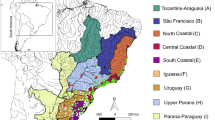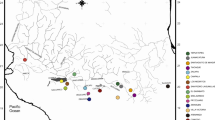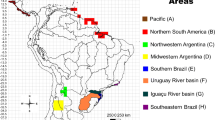Abstract
The geographic distribution of Japanese primary and some secondary freshwater fishes was analyzed using parsimony analysis of endemicity (PAE). Analysis of 73 taxa (species and intraspecific forms) on the four main islands of Japan (divided into 25 geographic areas), produced 44 most parsimonious cladograms. In all of the latter, a total of eight single and compound areas were recognized as endemic areas in nested relationships. The area cladograms showed Japan as comprising a middle-eastern Hokkaido area plus southern areas, the latter containing mainly a northeastern-Honshu endemic area and more heterogeneous southwestern areas, including four endemic areas (western Kyushu, southeastern Chugoku, middle Kinki and Tokai around Ise Bay) and several peripheral areas. Some patterns, e.g., the distinction in fauna across Fossa Magna, noted by previous studies, were supported by these results. Even though the analysis had some problems (e.g., not all geographic ranges of taxa could be included), it provided evidence for the detection of general distribution patterns, because the relationships or similarities among areas were clearly defined by shared taxa. To demonstrate the historical implications of the analysis, the allopatric distribution of, four bagrid catfishes was reconsidered in the area cladogram. The general pattern implied secondary extinction ofPseudobagrus nudiceps around lse Bay, which was in keeping with the fossil record.
Similar content being viewed by others
Literature Cited
Aoyagi, H. 1957. General notes on the freshwater fishes of the Japanese Archipelago. Taishukan, Tokyo. 272+17+20 pp. (in Japanese.)
Division of Natural Protection of the Environmental Agency of Japan. 1988. The 3rd survey for the basis of conservation of natural environment: report of the distribution of animals and plants, freshwater fishes. Environmental Agency of Japan. Tokyo, 293 pp. (in Japanese).
Division of Natural Protection of the Environmental Agency of Japan. 1993. The 4th survey for the basis of conservation of natural environment: report of the distribution of animals and plants, freshwater fishes. Environmental Agency of Japan, Tokyo, 408 pp. (In Japanese.)
Goto, A., T. Nakanishi, H. Utoh and K. Hamada. 1978. A preliminary study of the freshwater fish fauna of rivers in southern Hokkaido. Bull. Fac. Fish. Hokkaido Univ., 29: 118–131.
Hiba-kagakukyoiku-shinkokai (ed.): 1990. Freshwater fishes in Hiroshima Prefecture. Chugoku-shinbunsha, Hiroshima. 229 pp. (In Japanese).
Hidaka, H. and Y. Yabumoto. 1994. List of fishes in the Murasaki River (1). Watashitachi-no-Shizenshi (Kitakyushu-Shizenshi-Tomonokai-shi), (50): 18–21. (In Japanese.)
Higuchi, Y.. 1981. Freshwater fish fauna of Mie Prefecture. Rep. Mie Pref. Mus., Ser. Natural Science, (2): 69–100, (In Japanese.)
Honma, Y.. 1978. Freshwater fishes in Niigata Prefecture. Dobutsu to Shizen (Animals and Nature), 8 (10): 8–13. (In Japanese.)
Hosoya, K.. 1982. Freshwater fish fauna of the Yoshii River, Okayama Prefecture. Bull. Biogeogr. Soc. Japan., 37: 23–35.
Hosoya, K.. 1986. Interrelationships of the Gobioninae (Cyprinidae). Pages 484–501in T. Uyeno, R. Arai, T. Taniuchi and K. Matsuura, eds. Indo-Pacific fish biology: Proceedings of the second international conference on Indo-pacific fishes. Ichthyological Society of Japan, Tokyo.
Hosoya, K.. 1993. Cyprinidae and Cobitidae. Pages 212–235 and 1258–1261.in T. Nakabo, ed. Fishes of Japan with pictorial keys to the species. Tokai Univ. Press, Tokyo. (In Japanese.)
Humphries, C. J. and L. Parenti. 1986. Cladistic biogeography. Oxford Monographs on Biogeography. Clarendon Press, Oxford. xii+98 pp.
Itai, T.. 1982. Freshwater fishes in Shizuoka Prefecture. Daiichi-hoki, Tokyo. 208 pp. (In Japanese.).
Itai, T. and N. Kanagawa. 1989. First supplement of freshwater fishes in Shizuoka Prefecture. Bull. Shizuoka Women's Univ., (21): 71–81. (In Japanese.)
Itai, T., N. Kanagawa and M. Sugiura. 1990. Second supplement to freshwater fishes in Shizuoka Prefecture. Bull. Shizuoka Women's Univ., (22): 65–94. (In Japanese.)
Kawanabe, H. and N. Mizuno. 1989. Freshwater fishes of Japan. Yama-Kei, Tokyo. 719 pp. (In Japanese.)
Lindberg, G. U.. 1972. Large-scale fluctuations of sea level in the Quaternary period: Hypothesis based on biogeographical evidence. Nauka, Leningrad. 548 pp. (Japanese translated by T. Shinbori and F. Kanemitsu, 1981. Tokai Univ. Press., Tokyo ix+366 pp.)
Maeda, H., K. Watanabe and Y. Taki. 1994. Genetic relationships of the Japanese bagrid catfishes. J. Tokyo Univ. Fish., 81: 111–121.
Miyadi, D., H. Kawanabe and N. Mizuno. 1976. Coloured illustration of the freshwater fishes of Japan. Hoiku-sha, Osaka. 462 pp. (In Japanese.)
Mizoiri, S., N. Takeshita, S. Kimura and O. Tabeta. 1997. Geographic distributions of two bagrid catfishes in Kyushu. Japan. Suisanzoushoku, 45: 497–503.
Mizuno, N. and A. Goto. 1987. Freshwater fishes in Japan: their distribution, variation and speciation. Tokai Univ. Press, Tokyo. ix+244+33 pp. (In Japanese.)
Mo, T.. 1991. Anatomy and systematics of Bagridae (Teleostei), and siluroid phylogeny. Koeltz Scientific Books, Koenigstein. 216 pp., 63 figs.
Morrone, J. J.. 1994. On the identification of areas of endemism. Syst. Biol., 43: 438–441.
Morrone, J. J. and J. V. Crisci. 1995. Historical biogeography: Introduction to methods. Annu. Rev. Ecol. Syst., 26: 373–401.
Myers, G. S.. 1949. Salt tolerance of fresh-water fish groups in relation to zoogeographical problems. Bijdragen tot de Dierkunde, 28: 315–322.
Nagoshi, M.. 1978. Geographic distribution of freshwater fishes in Mie Prefecture. Tansuigyo (Freshwater Fishes), (4): 12–17. (In Japanese.).
Nakamura, M.. 1963. Keys to the freshwater fishes of Japan fully illustrated in colors. Hokuryukan. Tokyo. 258 pp. (In Japanese.)
Nelson, G. and N. I. Platnick. 1981. Systematics and biogeography: cladistics and vicariance. Columbia Univ. Press, New York. xi+567 pp.
Nishimura, M. and Y. Nagata. 1984. OnRhodeus suigensis andR. atrenius. Tansuigyo (Freshwater Fishes), (10): 67–70. (In Japanese.)
Nishimura, S.. 1974. Nihon-kai no seirtsu (Formation of the Sea of Japan). Tsukiji-Shokan. Tokyo. 227 pp. (In Japanese.)
Nishimura, S.. 1980. Nihon-kai no seiritsu (Formation of the Sea of Japan), 2nd ed. Tsukiji-Shokan, Tokyo, 230 pp.
Ochiai, A., K. Teraoka and N. Hanzawa. 1979. A survey of freshwater fishes of Kochi Prefecture. Res. Rep. Kochi Univ., 28: 145–159. (In Japanese.)
Okada, Y.. 1959. Studies on the freshwater fishes of Japan, I. General Part. J. Fac. Fish. Pref. Univ. Mie, 4: 1–265, pl. I–XII.
Okazaki, T., M. Watanabe, K. Mizuguchi and K. Hosoya. 1991. Genetic differentiation between two types of dark chub,Zacco temmincki, in Japan. Japan. J. Ichthyol., 38: 133–140.
Rosen, D. E.. 1978. Vicariant patterns and historical explanation in biogeography. Syst. Zool., 27: 159–188.
Rosen, B. R.. 1988. From fossils to earth history: applied historical biogeography. Pages 437–481in A. A. Myers and P. S. Giller, eds. Analytical biogeography, an integrated approach to the study of animal and plant distributions. Chapman & Hall, London, New York, Tokyo, Melbourne and Madras.
Sakaizumi, M., K. Moriwaki and N. Egami. 1983. Allozymic variation and regional differentiation in wild populations of the fishOryzias latipes. Copeia, 1983: 311–318.
Shimizu, Y.. 1992. History of freshwater fishes distributed around Ise Bay. Fujiwaradake (Report of Fujiwaradake Natural Science Museum), 15: 19–25. (In Japanese.)
Swofford, D. L. 1993. PAUP: Phylogenetic analysis using parsimony, version 3.1. Computer program distributed by the Illinois Natural History Survey, Champaign, Illinois.
Swofford, D. L. and D. P. Begle. 1993. PAUP: Phylogenetic analysis using parsimony, Version 3.1, user's manual. Illinois Natural History Survey. Campaign, Illinois. vi+257 pp.
Takahashi, Y. and Y. Sakaguchi. 1976. Rivers in Japan. Kagaku, 46: 488–499. (In Japanese.)
Takeuchi, M. and K. Hashimoto. 1990. Faunal analysis of freshwater fishes in the northeastern part of Honshu Island, Japan. Bull. Biogeogr. Soc. Japan, 45: 127–135. (In Japanese with English abstract.)
Tanaka, S.. 1991. Freshwater fishes in Toyama Prefecture: distribution and its characteristics. Pages 137–141in K. Goto, ed., Nature and culture of Toyama. Fac. Sci., Toyana Univ., Toyama. (In Japanese.)
Tanaka, S., H. Kobayashi and Y. Nakanishi. 1987. Supplement to “the distribution of freshwater fish in Toyama Prefecture”. Bull. Fac. Edu. Toyama Univ. Ser. B, (35): 11–24.
Tanaka, S., K. Tonoyama, S. Miyazaki, H. Kobayashi and N. Mizuno. 1976. Distribution of freshwater fishes in Toyama Prefecture. Bull. Fac. Edu. Toyama Univ. Ser. B, (24): 195–206.
Tomoda, Y.. 1968. Ichthyo-faunal relationship between the Nobi Plain and the system of Lake Biwa. J. Bioeducation High-school, Gifu Pref. (Seibutsu-Kyoiku), 13: 2–6. (In Japanese.)
Tsubokawa, K.. 1988. Zoogeographical consideration on the freshwater fish fauna of the Okayama Region, Japan. Bull. Kurashiki Mus. Nat. Hist., 3: 1–30. (In Japanese with English abstract.)
Ueno, K.. 1985. Karyotypes of Japanese and Korean bagrid fishes. Kaiyo-kagaku, 17: 102–108. (In Japanese with English abstract.)
Ueno, K.. 1987. Bagridae. Pages 71–80in N. Mizuno and A. Goto, eds. Freshwater fishes in Japan: their distribution, variation and speciation. Tokai Univ. Press, Tokyo, (In Japanese.)
Watanabe, K. and H. Maeda. 1995. Redescription of two ambiguous Japanese bagrids,Pseudobagrus aurantiacus (Temminck and Schlegel) andP. tokiensis Döderlein. Japan. J. Ichthyol., 41: 409–420.
Wiley, E. O.. 1988a. Parsimony analysis and vicariance biogeography. Syst. Zool., 37: 271–290.
Wiley, E. O.. 1988b. Vicariance biogeography. Annu. Rev. Ecol. Syst., 19: 513–542.
Author information
Authors and Affiliations
About this article
Cite this article
Watanabe, K. Parsimony analysis of the distribution pattern of Japanese primary freshwater fishes, and its application to the distribution of the bagrid catfishes. Ichthyological Research 45, 259–270 (1998). https://doi.org/10.1007/BF02673924
Received:
Revised:
Accepted:
Issue Date:
DOI: https://doi.org/10.1007/BF02673924




